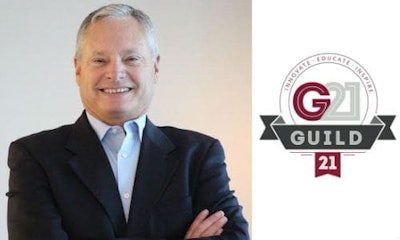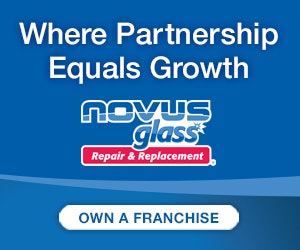
Jay Perry, consultant and columnist for Collision Repair magazine, was the guest on the latest Guild 21 Conference Call.
By Jeff Sanford
Toronto, Ontario — April 17, 2017 — Jay Perry, management consultant and columnist for Collision Repair magazine, was the guest on the latest Guild 21 Conference Call. His advice on leadership offered lessons from his book, Success Manifesto, and will be appreciated by managers hoping to build a resilient and sustainable collision repair business.
Perry’s “Who’s Driving” has appeared in every issue of Collision Repair magazine to date. During the latest Guild 21 Conference Call, Perry highlighted eight tenets to developing leadership abilities.
Perry was born into a family of entrepreneurs. Working in the family business, he learned first-hand the importance of focus, hard work, efficiency and personalized customer service. He also came to understand the nuances and challenges of running a small to medium-sized enterprise. Putting these lessons to work, he found himself in charge of a multi-million dollar collision repair business in Toronto by the time he was just 30 years old. Having taken the business to unexpected heights, he soon returned to school and graduated with a degree in psychology, which helped him in his life-long study of the principles underlying successful business management.
In 1990 Perry created his own consultancy to help shops design successful leadership strategies and systems. Since then he has branched out to consult for non-auto related businesses. Today Perry’s clients range in size from between $3 million to $300 million in sales. His Leadership Development Course helps clients sustain improvements to the business by improving the leadership skills within their organizations. According to Perry, leadership skills are more important today than ever.
“Leadership can create a company or destroy one if done incorrectly,” says Perry. “The educational requirement for leadership has never been so high. A once less-complex industry is more sophisticated.”
The managers of collision repair centres have been inundated with many demands in terms of human resources, communications problems, legal compliance and age issues. Multiple generations need to be managed simultaneously and new employees recruited.
“There are all kinds of new issues that need to be dealt with [beyond vehicle repair]. People are time-pressed to perform at an increasingly higher level … and there is a cost associated with poorly trained leaders,” says Perry.
But even as the need for leadership expands it is only recently that more attention has been paid to the issue among educators in the collision repair industry and trades in general.
“Leadership education has lagged behind in this industry for years. We’ve had trade schools available. But only now is leadership making its way onto the area of leadership in a few schools … The teaching of leadership skills is just now starting to become a part of the education curriculum,” he says.
The training comes just in time. Today a massive number of businesses are about to change hands in North America as the boomer demographic begins to retire. Over the next 10 years the number of businesses in North America that will fall into new and less-experienced hands will be about 1.1 million, according to Perry.
That may make it more difficult to find and retain talent. Strong leadership is one way to combat this issue. Thirty percent of people quitting a job are actually “quitting the boss,” creating a massive bill of $146 billion a year in turnover costs, according to Perry.
“There is such a competitive landscape for good people. You’re not competing against other businesses in your own industry … you are actually competing against other industries,” he says. “It’s clear. Leadership is important.”
Perry believes developing leadership skills has to be a considered and ongoing process, a regular part of operations. Perry summarized eight tenets for developing leadership skill for the Guild 21 audience.
1. There is no such thing as a “Born Leader”
Leaders are not born, but developed and trained, says Perry.
“We hear that this or that person is a ‘born salesman.’ I don’t believe in that. I believe leadership skills are learned abilities,” he says.
Putting in the supports that can allow someone to develop as a leader is what it takes to develop the skills in an employee.
“These are teachable skills. People advance when given the opportunity to learn,” says Perry. Those already in leadership positions need to create the environment that allows that learning to happen. For those seeking out leadership opportunities, says Perry, “If your environment does not provide that education … find a new organization. You need to be with or create a progressive organization.”
2. Be very specific in your goals and how you measure your success
“Without having goals outlined, you’ll wander aimlessly,” says Perry. “People with clear, written goals accomplish far more in a shorter period of time than people without them could ever imagine. It is imperative we have goals, with great detail, so we can measure progress.”
3. Stay humble and practice active listening
Drop the defence, keep an open mind and listen. This is how the successful leader stays in tune with employees. “The effectiveness of a leader is in this ability to connect with workers,” says Perry. “Stay humble and practice active listening. The mindset of humility allows us to have empathy for those around us. Bring those skills to bear.” Also, take notes so you can remember what was said.
4. Follow-up is a key attribute that will keep people on-track and improve your leadership image
Follow-up shows that you care about the employee improving and getting better. “It shows you value your co-workers’ opinions. Repeat back what the speaker just said to you. When you follow up take the
opportunity to reinforce the content. You reinforce their image of you as a leader,” says Perry. “Reinforcing content improves perception by others and keeps people on track.”
5. Manage procrastination with touch points
Any planned project should include, “touch points,” goals and dates by which certain milestones of a project are achieved. This helps avoid sluggishness in terms of completion.
“Procrastination can derail good leadership plans,” says Perry. “Setting interim goals to measure progress made along the journey is important … When it comes to gross profit margin, with better training you can generate better flow. You get to goals in a safer fashion.”
6. Success is accomplished in small doses
“Stop looking for a magic bullet,” says Perry. “We have become acclimatized to immediate gratification. Leadership development does not happen that way.” It takes time to develop someone to handle management tasks. Perry says a rough guide is that it takes 18 months to two years before a tech becomes truly proficient. But the average supervisor is in a position of leadership nine years prior to receiving any leadership development training at all.
“Developing leadership takes time. Think of the hours technical people put in so they don’t have to do a job over again. It is the same thing with leadership,” says Perry.
7. Provide others with an opportunity for growth and a supporting pathway
For the employees that are most vital to the organization it is important to plan out growth pathways for advancement and to support those goals. “Older workers might want to take on different types of jobs. Create pathways so you don’t lose good people,” says Perry.
8. Look for leadership ability and nurture it
When you discover a specific aptitude in an employee make sure you allow that talent to be developed. “You are looking for the initiators that you can explore this kind of a future with. Identify leadership characteristics in the raw material you’re working with,” says Perry. Once the right employees are identified, “Training is relatively inexpensive. But you need to spend some time and money on that validation process.”
Step carefully through this process as those identified can often react in alarm. “People are scared of this, worried that you are going to find out their deepest, darkest secrets. We look for strengths, not for the drawbacks,” says Perry.





















